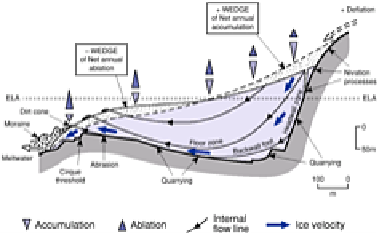Environmental Engineering Reference
In-Depth Information
thickness and overall surface slope exceeds the yield stress and equilibrium is restored
only by ice flow.
Ice flow style in this or any other glacier is determined by the snow-ice transformation
process, basal ice temperature (warm- or cold-based) and the nature and slope of
Figure 15.5
Model mass balance of a cirque glacier, showing
net accumulation and ablation wedges, ice flow lines, relative
velocities and associated geomorphic processes.
the glacier bed as well as its surface. Intergranular or regelation creep, already identified
as initiating ice flow, is one component of
internal deformation
where parts of the
glacier move relative to others. At a larger scale, ice behaves like a viscous fluid in its
boundary layer - with lower velocities close to the bed or valley sides - and like a brittle
solid where velocities exceed plastic deformation rates, forming tell-tale crevasses and
shear planes (Figure 15.6, Plate 15.3). Cold-based glaciers may be frozen to their bed,
while ice higher in the glacier shears past the stationary basal layer. Warm-based glaciers,
and zones of pressure-melting in cold-based glaciers, also slide past their bed and valley
sides.
Basal sliding
is facilitated by a thin water film between ice and substrate or by a
deformable bed (see box, p. 323). Surface water (from rainfall or melt) may reach the bed
in thin glaciers and average geothermal heat flux is capable of melting some 6 mm a
−1
of
basal ice. The principal source of water, however, is pressure-melting. This occurs quite
readily in isothermal ice. It is also induced here, and in colder ice, where basal stress
increases on the upstream side of bedrock obstacles. The resultant supercooled water
reduces bed friction, encouraging the glacier to slide past or around the obstacle, and
regelates as stress falls downstream.
ICE FLOW PATTERNS AND VELOCITIES
All glaciers flow through a combination of internal deformation and basal sliding. The
proportion of both varies according to thermodynamic character and according to

